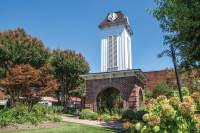A new meaning for ‘study lounge’: WCU installs solar panel and hammock lounge combo with sustainability funds
 When Earth Day rolls around this year, students at Western Carolina University will be able to celebrate with a bit of high-class hammocking, with the date marking completion of what’s been dubbed the Electron Garden on the Green — believed to be the nation’s first combination solar-generating facility and hammock hanging lounge on a college campus.
When Earth Day rolls around this year, students at Western Carolina University will be able to celebrate with a bit of high-class hammocking, with the date marking completion of what’s been dubbed the Electron Garden on the Green — believed to be the nation’s first combination solar-generating facility and hammock hanging lounge on a college campus.
“We’re excited about it, and I think the students are pretty excited as well,” said Lauren Bishop, sustainability officer for WCU.
The project is just the first in what’s sure to be a long line of sustainability-oriented endeavors funded through a student fee added in fall 2014. The $5-per-semester fee is part of the university’s Sustainability Energy Initiative and aims to support projects related to environmental sustainability. It currently generates just under $80,000 per year.
Bishop is especially enthusiastic about this, the first project, because it was funded, designed and approved by students.
“We really wanted them to feel like out of the gate the first project is something they would really want with their money, and the buzz around campus is that they’re really excited about it,” Bishop said.
The student-comprised Sustainability Energy Initiative Committee began taking proposals for projects to fund in the spring of 2015, accepting ideas from students, staff and faculty. Proposals ranged from permanent structures to internships to research projects, all surrounding a common theme of sustainability and educational value.
The Electron Garden concept came from three senior students — Ross Heffley, Robert Bianculli and Chase Weddle — who designed it as a senior capstone project for the Department of Engineering and Technology. The 10-kilowatt solar system will supply power to WCU’s grid, reducing both energy costs and carbon dioxide emissions.
But the structure will have a dual purpose as well — it will include hanging space for about 10 hammocks, plus electrical outlets and Internet and USB ports.
That’s something that’s sure to attract interest, said Zach Waldroup, a WCU student who interns with the university’s Office of Sustainability and Energy Management while also serving on the SEI Committee. “Hammocking” — also called “ENO-ing” in reference to Asheville-based hammock company Eagle Nest Outfitters — has surged in popularity on college campuses in recent years.
Capitalizing on the fad, said Bishop, will also serve to boost the university’s goal of getting students outside, defying the statistic that the average American spends about 90 percent of his or her time indoors.
“We wanted to try to build something that would promote our students to get outside and enjoy that connection with the outdoors and what is unique and beautiful about our campus,” said Bishop.
For Waldroup’s part, he’s celebrating the impending completion of the Electron Garden as the culmination of years of work by an ever-changing student body.
“Years of hard work and determination from our predecessors (in campus environmental advocacy) is finally about to pay off with our first project,” he said. “It will put a face to the Sustainability Energy Initiative, and I believe it will really jump-start interest in our efforts and overall campus sustainability.”
The roots of the SEI trace back to 2006, when a proposal for the committee was first drafted by WCU alumnus McKenzie Dillingham, who was then president of the student environmental advocacy group Eco CATS.
The Electron Garden project will cost about $60,000, a figure that’s about half of what it would cost if most of the work wasn’t being done in-house — electricians in the Office of Facilities Management have been “great partners” in bringing the project to fruition, Bishop said.
The Electron Garden isn’t the only project that the sustainability fee has brought to the horizon. In April, artists from Camp Little Hope — a collective of artists, writers and designers — will arrive for a six-week residency to help students create nature-based sculptures for installation on the university’s multi-use trail system.
“The whole concept of their installation is really awesome,” said Bishop. “It basically portrays how the forest is a living, breathing entity, so they’re going to try to encapsulate that with this project.”
That project, the second of the two funded through the first year of sustainability fees, was proposed by Denise Drury Homewood, director of the Fine Art Museum at WCU.
As to what the next year’s projects will entail, that remains to be seen. Proposals for 2016 are due this week, meaning students serving on the SEI Committee will soon be busy sifting through them in search of the next batch of winning ideas.
When you go
The ribbon-cutting for the new solar generation and hammock lounging combo is slated for Friday, April 22 — Earth Day.
That’s already a busy day at Western Carolina University, when the school’s annual Earth and Wellness Celebration will offer plenty of opportunities for diversion. Among other attractions, this year’s event will include live music, a drum circle and a presentation on the cultural relationship between the Cherokee people and their waterways, given by Barbara Duncan, education director at the Museum of the Cherokee Indian.
For a complete schedule, visit http://bit.ly/1pUQMXl.





